A calf massage is focused on the gastrocnemius, soleus and plantaris muscles located in the lower half of the leg. A calf massage involves various techniques aimed to reduce pain and improve recovery. A calf massage aims to relieve muscle tightness and tension to enable full recovery, and help a person return to exercise. Our massage therapists at Physio.co.uk use calf massage to treat muscle tightness, tension and pain.
What techniques are used in a calf massage?
There are many techniques used in a calf massage. The most common techniques include:
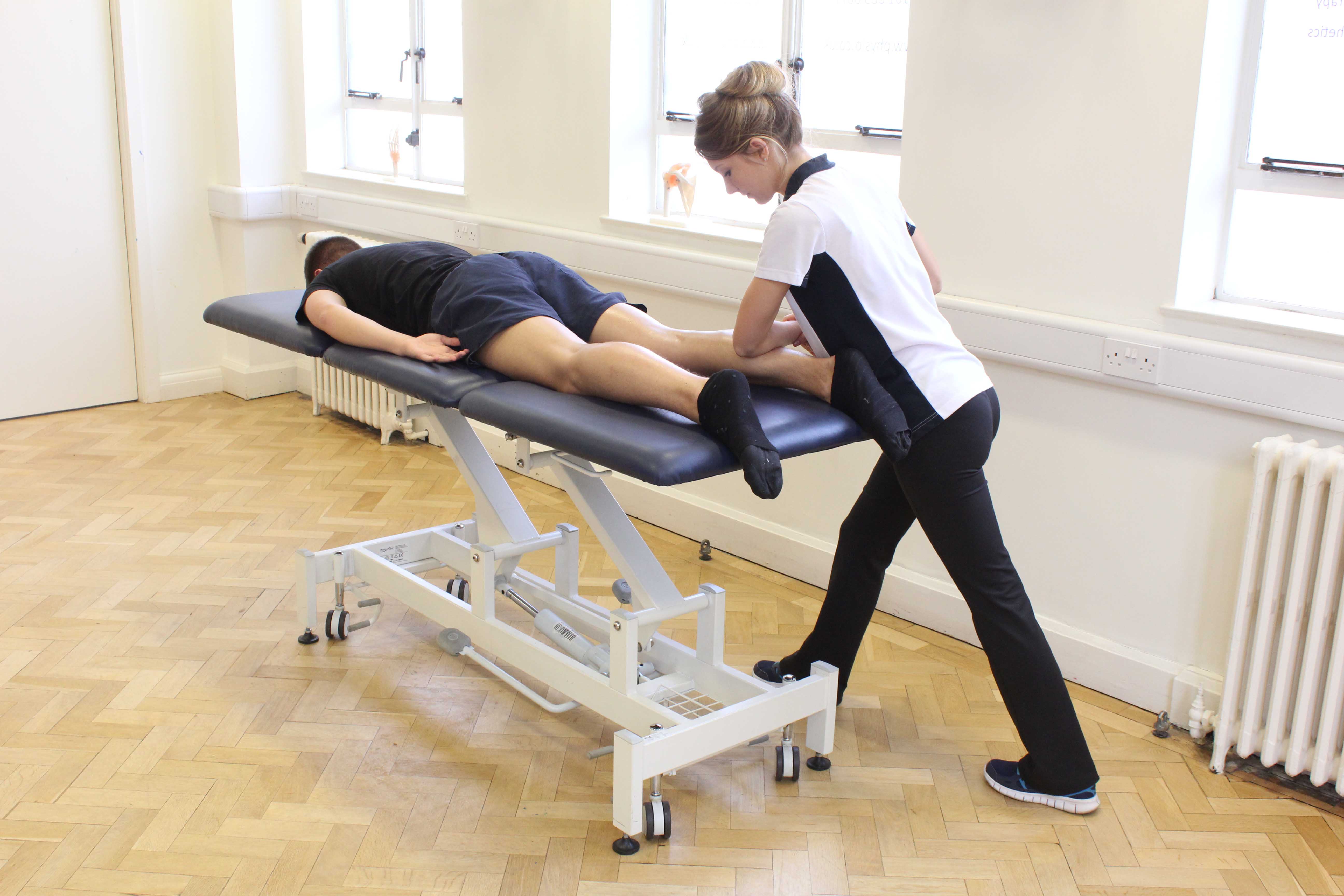 Above: Deep tissue massage of gastrocnemius and soleus muscle
Above: Deep tissue massage of gastrocnemius and soleus muscleSkin rolling is a common technique used during a calf massage. Skin rolling is where skin is picked up and rolled between the fingers and thumbs. Skin rolling aims to relieve tightness of muscles and fascia to help reduce pain. Fascia is located beneath the skin and is a thin layer of tough, fibrous connective tissues. The tightness of muscles and fascia is released as muscle temperature is increased. Increasing the temperature of the muscles improves tissue elasticity. Improving tissue elasticity reduces muscle and fascia tightness and restriction also decreases.
An effective technique used during a calf massage is hacking. Hacking is a type of tapotement technique performed using the middle part of the side of the hand. The fingers and wrists are kept soft which allows the fingers to get to the tissues. The pressure and speed when using hacking can vary depending on personal preference or the type of problem that is occurring. Hacking helps relax muscles by relieving muscle tightness and tension. Cellular exchange is stimulated as blood vessels widen and are brought closer to the surface of the skin. When blood vessels widen and are brought closer to the surface of the skin, this is called vasodilation. Cellular exchange allows healthy oxygen and nutrients and waste products and toxins to be exchanged in and out of the muscles more efficiently.
An effective technique used during a calf massage is effleurage. Effleurage varies in pressure and is performed with flat hands and fingers. Effleurage increases the temperature of the muscles through friction created between the hands and skin. Increasing muscle temperature improves tissue elasticity therefore reducing muscle tightness, tension and stress. Reducing muscle tightness, tension and stress also relieves pain.
A calf massage is used for lymphatic drainage. Lymphatic drainage is a specific massage where pressure is applied in upwards movements, in the direction of glands. Lymphatic drainage helps remove waste products and toxins from the skin through glands and reduce swelling.
Waste products are removed through the lymph flow. The lymph flow takes the waste products and removes them out through glands. There are many different glands in the body, the most known glands being sweat glands. Lymphatic drainage of the calf removes waste products through the gland located behind the knee. A calf massage helps to stimulate the lymphatic system and improve lymph flow. Improving lymph flow encourages waste products and toxins to be removed from the tissues more efficiently.
An efficient lymphatic system can also reduce swelling. Swelling can occur for many reasons. One reason swelling can occur is due to a condition called lymphedema which can be a result of surgery or infection. Lymphedema is caused by the restriction of lymph flow. Restricting lymph flow results in a build-up of waste products and toxins and reduced cellular exchange. Cellular exchange is where waste products and toxins in muscles and tissues are exchanged for oxygen and healthy nutrients. Lymphatic drainage helps improve the lymphatic flow so that restriction of the lymph flow is reduced so that swelling can be reduced.

When can a calf massage help?
A calf massage can help in various situations. Situations when a calf massage can help include:
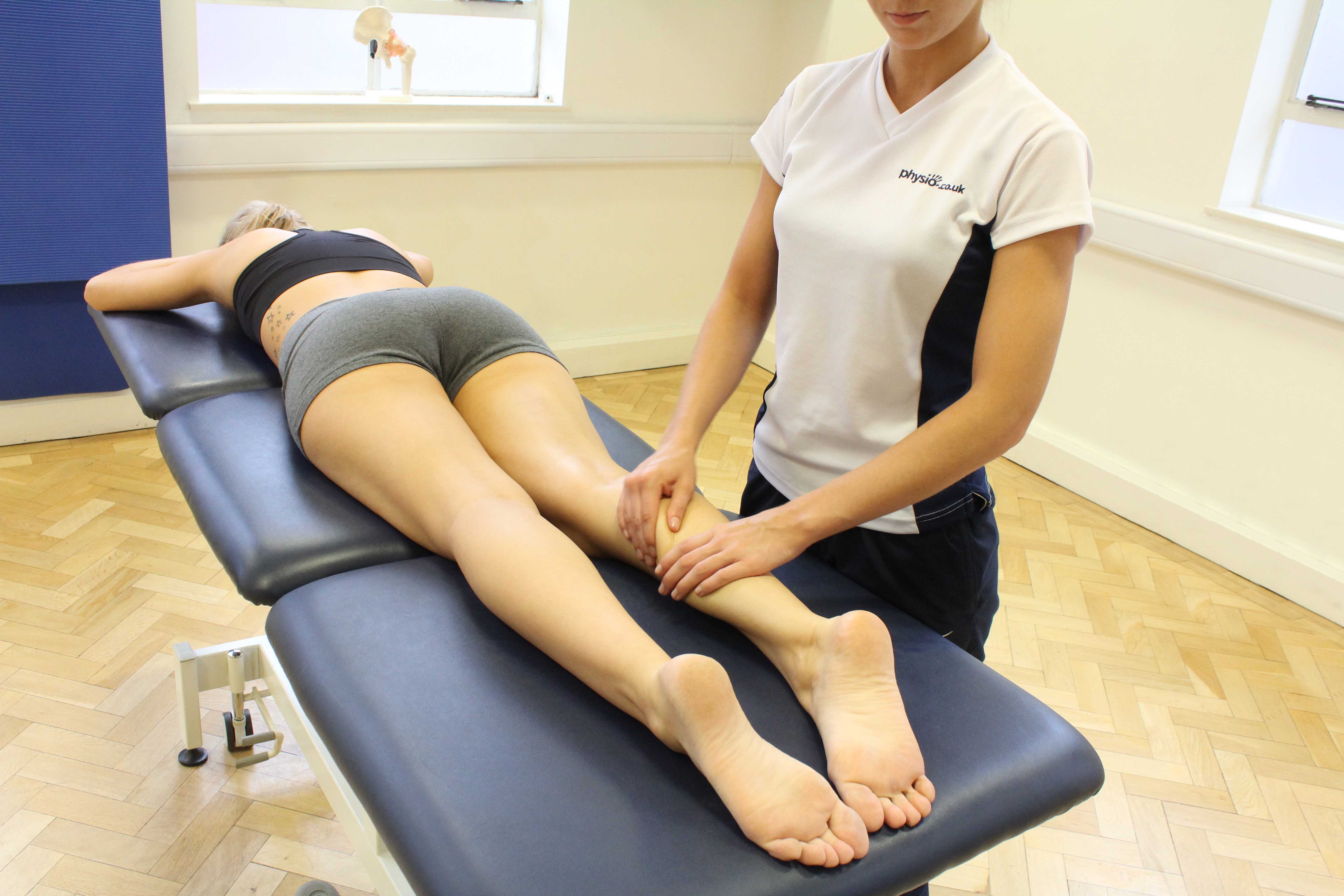 Above: Rolling massage technique applied to gastrocnemius and soleus muscles
Above: Rolling massage technique applied to gastrocnemius and soleus musclesHow does a calf massage help delayed onset muscle soreness?
A calf massage can help treat delayed onset muscle soreness. Delayed onset muscle soreness usually occurs up to 72 hours after activity. There are various reasons for delayed onset muscle soreness to occur such as overuse and inefficient cool down after intense exercise.
A calf massage aims to treat delayed onset muscle soreness by decreasing inflammation, improving blood circulation and stimulating lymphatic flow.
Delayed onset muscle soreness can be caused by overstretching during activity which creates microscopic tears in the muscle fibres. Tears in the muscle fibres increase inflammation which increases muscle tightness and pain. A calf massage reduces inflammation by increasing the amount of blood vessels at the site of injury, to help remove the build-up of fluids that created a protective layer.
A calf massage can improve blood circulation. An increase in blood circulation is encouraged as skin and fingers create friction. Improving blood circulation provides an increase of healthy nutrients and oxygen to the muscles to provide them with more energy. Microscopic tears in muscle fibres can occur after intense activity, increasing the effects of delayed onset muscle soreness. An increase in oxygen and nutrients due to improved circulation, can also contribute towards the repair of damaged muscles.
The lymphatic system is stimulated during a calf massage. Stimulation of the lymphatic system encourages metabolic wastes such as lactic acid, to be removed from the muscles more efficiently. During activity, an increase in lactic acid is built up in the muscles. When a cool down is not complete, the level of lactic acid remains the same resulting in an increase in muscular fatigue and delayed onset muscle soreness. When the lymphatic system is stimulated, the build-up of lactic acid and other waste products is reduced and removed through the lymph flow. Removing metabolic wastes decreases muscular fatigue and the effects of delayed onset muscle soreness.
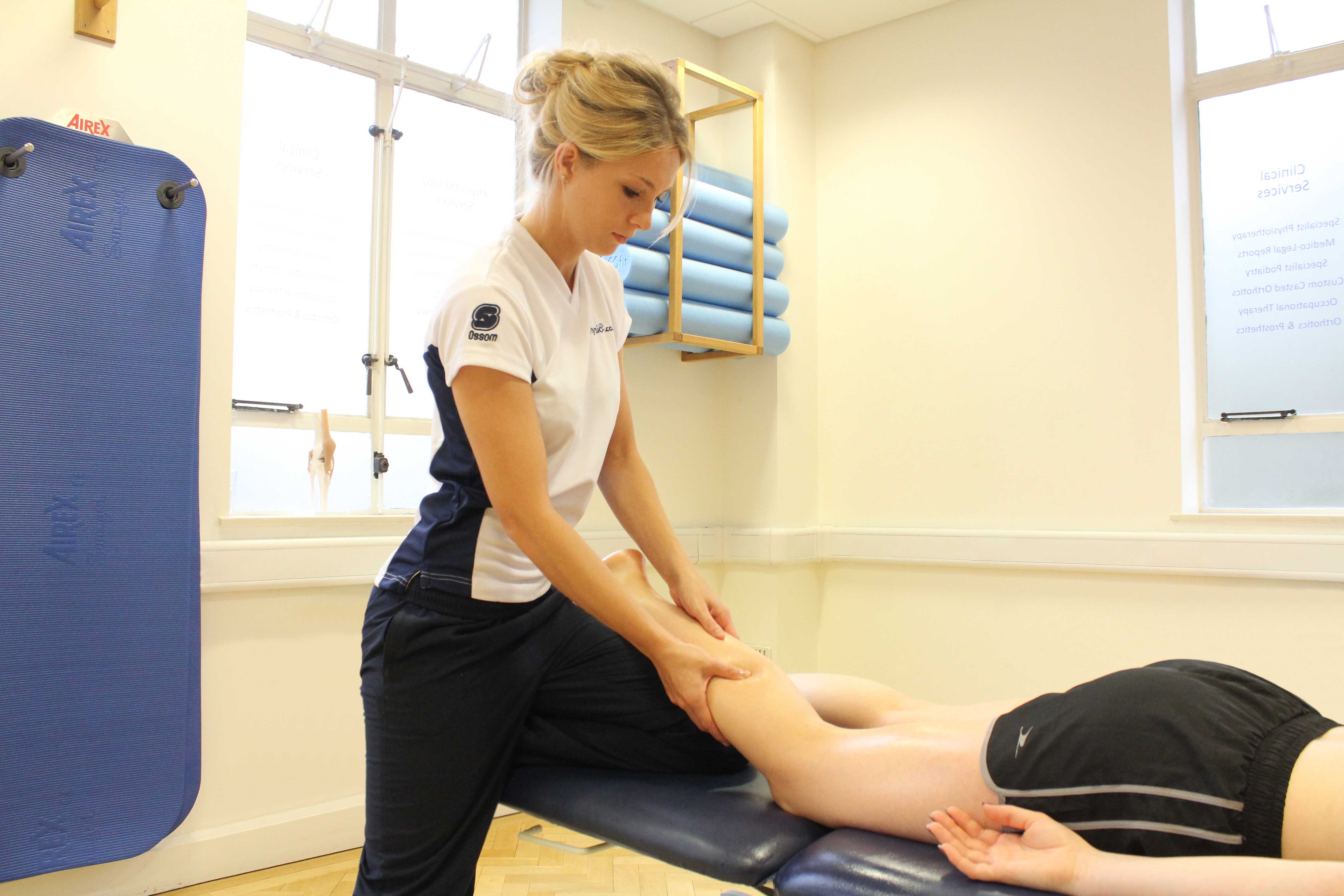 Above: Deep tissue massage of gastrocnemius and soleus muscle
Above: Deep tissue massage of gastrocnemius and soleus muscleHow does a calf massage help pre event?
A calf massage can help before exercise or competition. A calf massage helps people get mentally and physically prepared for activity.
A calf massage aims to prepare people for activity by relieving muscle tightness, prevent injury and prepare the person psychologically.
Muscles tend to be tight and have a shorter range of movement before exercise. A calf massage aims to relax muscles so that they improve in flexibility. Flexibility of a muscle is improved as muscles increase in temperature. An increase in muscle temperature occurs as blood circulation is improved. As well as an increase in flexibility, an increase in tissue elasticity also occurs. Increasing flexibility and elasticity of muscles enables them to stretch and relax, relieving tightness.
Injury is prevented as muscles become less restrictive and able to move more freely without pulling, straining or tearing a muscle. When muscle temperature rises during a calf massage due to the increase of blood circulation, the inelasticity of muscular tissues decreases. Inelasticity of muscular tissues causes restriction and decrease in muscles" range of movement. When inelasticity is decreased, range of movement is increased. Increasing range of movement allows the muscle to move more freely, reducing chances of injury during short, powerful bursts of movement.
A calf massage can help the athlete to become psychologically prepared in two different ways. A calf massage can increase the heart rate and adrenaline levels in the body. An increase in adrenaline allows the person to be full of energy for the intense exercise which is about to take place. A calf massage can also help a person relax. An increase of the relaxation hormones called serotonin and dopamine occurs, helping the body to mentally relax. Mentally relaxing the athlete allows them to become focused and ready for the event.
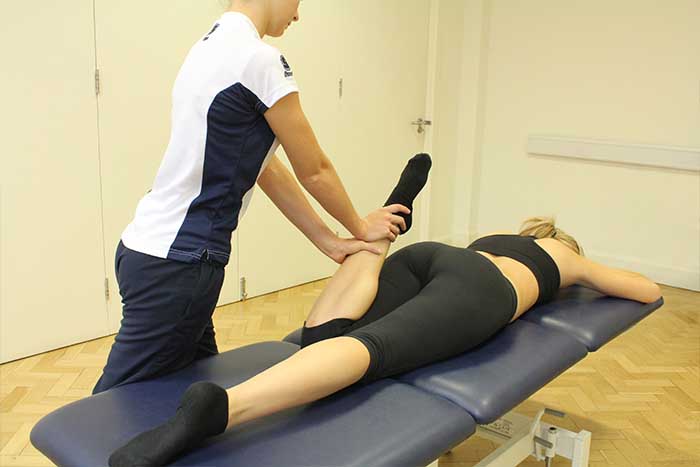
How does a calf massage help muscle tightness?
A calf massage can help treat tight muscles. Tight muscles occur for many reasons including injury, overuse and surgery. If not treated, tight muscles can result in high levels of pain and discomfort.
A calf massage aims to decrease muscle tightness by increasing circulation.
Friction is created between the skin and the hands during a calf massage. The friction created increases muscle temperature. Increasing muscle temperature improves the elasticity of tissues within the muscle. Improving tissue elasticity allows muscles to increase in flexibility and have a wider range of movement. Muscles are also able to relax when elasticity is increased. Increasing flexibility, range of movement and relaxation of the muscles helps to decrease tightness. Decreasing muscle tightness also helps to reduce the levels of pain and discomfort a person may have.
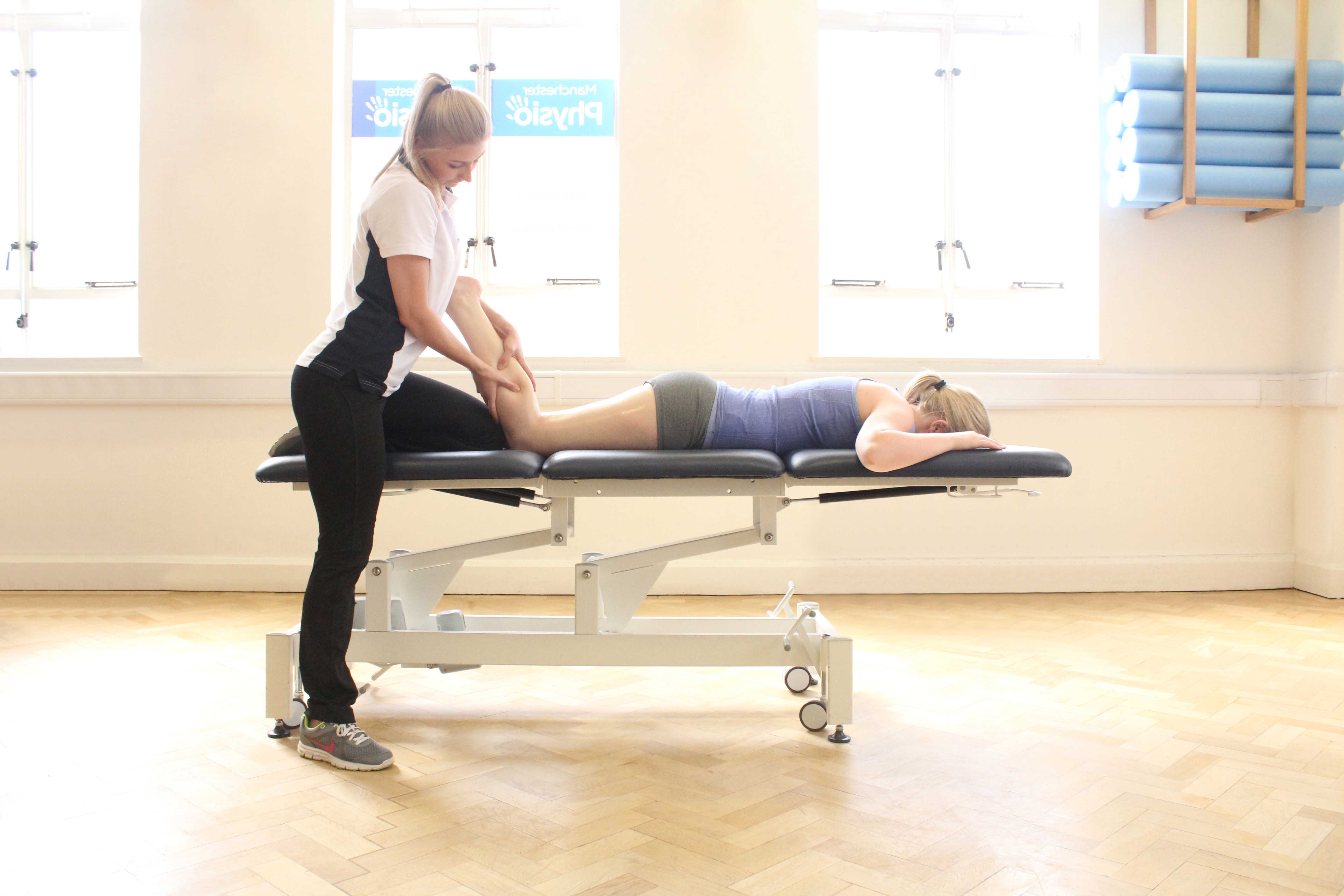 Above: Soft tissue massage of gastroc nemius and soleus muscle
Above: Soft tissue massage of gastroc nemius and soleus muscleHow does a calf massage help relaxation?
A calf massage can help the body relax. A calf massage helps relax the body both mentally and physically.
A calf massage helps the body to relax by decreasing muscle tightness and psychologically relaxing the person.
Muscles in the calf can become tight for many reasons such as injury or overuse. Tight muscles can cause pain and discomfort if left untreated. When friction is created between the skin and fingers, this increases the temperature of the muscles. Increasing the temperature of the muscles, improves tissue elasticity. Improving tissue elasticity, relieves tight muscles and allows the body to physically relax.
A calf massage increases the production of positive hormones. Serotonin and dopamine are both positive hormones secreted from the brain. Serotonin and dopamine can give a person a sense of well-being and also a "good mood" effect. A calf massage encourages the release of serotonin and dopamine to help increase a person's level of relaxation.
What are the benefits of a calf massage?
There are a range of benefits gained through a calf massage. The benefits gained from a calf massage include:
- Maximise Performance
- Increased flexibility
- Prevent delayed onset muscle soreness
- Improved circulation
How does a calf massage maximise performance?
A calf massage can benefit the body by maximising performance during activity.
A calf massage helps prepare the muscles for activity to maximise performance by increasing blood circulation and increasing range of movement.
Blood circulation is increased as friction is created between the skin and fingers. Increasing blood circulation allows an increase in oxygen and nutrients to be delivered to the muscles. An increase in oxygen and nutrients provides muscles with an increase in energy and reduces the build-up of metabolic wastes that can contribute to muscular fatigue. Increasing oxygen and nutrient levels is also essential in the maintenance of strong healthy muscles and helps repair damage the muscles may have before activity.
A calf massage also increases the elasticity and flexibility of muscles. Elasticity and flexibility is increased as muscle temperature rises due to improved circulation. Increasing elasticity and flexibility provides muscles with a wider range of movement. Increasing range of movement of muscles decreases tightness and tension. A combination of increased range of movement, decreased tightness and decreased tension helps avoid injury during short bursts of movement during activity.
How does a calf massage increase flexibility?
Increased flexibility is a common benefit gained from a calf massage.
A calf massage increases flexibility by improving tissue elasticity and relieving muscle tightness.
During a calf massage the manipulation of soft tissues and friction created between skin and fingers increases blood circulation. When blood circulation is increased, muscle temperature rises. Rising muscle temperature helps to improve tissue elasticity. Improving tissue elasticity allows the muscle to stretch and loosen and increase in range of movement. Stretching and loosening muscles increases flexibility.
Muscle tightness is commonly treated through a calf massage. Muscle tightness can cause restriction due to the inelasticity of muscle tissues. When muscle temperature is increased, the inelasticity of tissues decreases. Decreasing inelasticity reduces restriction. When restriction of tissue elasticity is reduced, muscle tightness is decreased. Relieving muscle tightness reduces pain and increases the movement of the muscle. Increasing muscle movement increases flexibility.
How does a calf massage help prevent delayed onset muscle soreness?
A calf massage can prevent delayed onset muscle soreness. After intense exercise, there is a build of waste products in the muscles. When waste products are built up in the muscles and are not removed, they can make the muscle fatigue more easily causing muscle tightness and pain.
A calf massage aims to prevent delayed onset muscle soreness by stimulating lymphatic system.
The lymphatic system helps remove waste products more efficiently from the muscles. The lymphatic system also aids in recovery as it fights of infection and provides a layer of protection around areas of the muscle that may be damaged. An efficient lymphatic system therefore prevents delayed onset muscle soreness.
How does a calf massage improve circulation?
A calf massage helps improve circulation.
Blood circulation is improved through a calf massage by increasing capillarisation and vasodilation.
During a calf massage capillarisation is increased. Capillarisation is where an increase in capillaries occurs. Increasing the quantity of capillaries enables an increase in oxygen to be available for the muscles to use. Increasing capillaries also provides a wider range of area that blood can be transported around a person's body. When the range of area is widened, circulation is increased.
Vasodilation can also be increased during a calf massage. Vasodilation is where blood vessels transporting blood around the body, become wider allowing an increase in blood flow. Blood vessels widen due to the muscle cells lining the walls of the vessels relax. Increasing vasodilation can therefore improve circulation.
Summary
A calf massage is used on the gastrocnemius, soleus and plantaris muscles located in the lower half of the leg. Techniques including skin rolling, hacking, effleurage and lymphatic drainage are used to help delayed onset muscle soreness, pre event, tight muscles and relaxation. Benefits of a calf massage include maximised performance, increased flexibility, prevention of delayed onset muscle soreness and improved circulation. Our massage therapists at Physio.co.uk effectively use a calf massage to treat delayed onset muscle soreness, pre event, muscle tightness and relaxation.
How can I arrange a calf massage?
The easiest way to arrange a calf massage at Physio.co.uk is to email us at office@physio.co.uk or call us on 0800 033 7800.
Alternatively if you have any questions please feel free to contact us.
We offer a 7 day service and provide home and clinic appointments.

 0330 088 7800
0330 088 7800


































